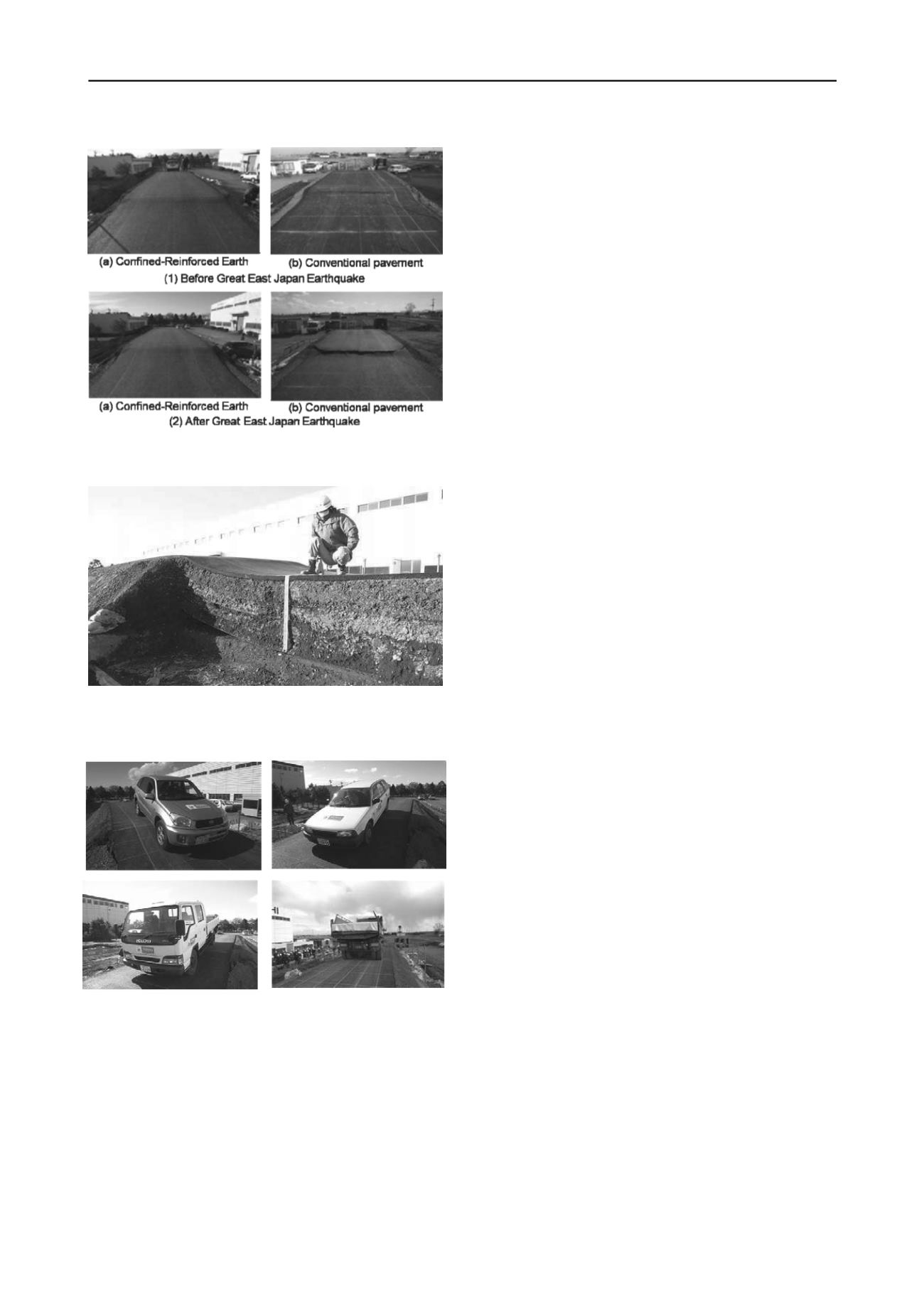
1336
Proceedings of the 18
th
International Conference on Soil Mechanics and Geotechnical Engineering, Paris 2013
Photographs 6. Seismic performance of Confined–Reinforced Earth
(
T
ested in Ibaraki, Japan, 2011).
ter the Great East Japan Earthquake (550mm
ifferential settlement).
t excessive differential
settlement of road embankments placed in vicinity to box
butments.
einforced earth
str
, as well as for
emergency restoration of plant functionality and other aspects of
ns (BCP).
Ts
it for Geotechnical Engineering in Practice of the
enter for Research and Development Initiatives, Chuo
Ishi
Oht
th
Uch
th
Uch
Photograph 7. Longitudinal cross section of Confined–Reinforced Earth
and asphalt pavement af
d
Photographs 8. Traficability tests of Confined-Reinforced Earth
safer and more durable roads and can be used as an anti-
earthquake measure to prepare roads for damage from major
earthquakes as well as a measure agains
culverts and/or bridge a
5 CONCLUSIONS
The structure of the seismic retrofit technique for asphalt
concrete pavements using Confined-Reinforced Earth (CRE),
construction method and the results of full scale in-situ tests
were described. Full scale in-situ tests show the acceptable
performance of CRE after the forced settlement to simulate the
severe earthquake-induced damage.
After experiencing the acceptable performance of high
rigidity confined-reinforced earth observed at trial embankment,
we still had two major technical problems related to (1)
relaxation of pre-stresses and (2) materials unfavourable to be
used. Apparently the degree of time dependency of the
relaxation of pre-stresses depends on the kind of compacted
material and degree of compaction. Distinct definition and
complete rejection of unfavourable materials are also
unavoidable factors to guarantee successful performance. To
avoid the difficulties arising from these two problems, the
authors have decided to use only crushed stones (and crushed
concrete) traditionally used as the base course materials. The
authors have also decided not to make the design of confined-
reinforced earth too much relying on the high level of pre-
stresses being implemented, i.e., the authors intend to make
design procedure that requires just confinement on the
movement of crushed stone particles and requires moderate pre-
stressing. In the course of developing reinforced earth
technology, the authors have tried to find out practical methods
of specifying the material parameters of compacted materials
and compacted crushed stones used in the r
uctures. Some of these methods are concisely summarized by
Ohta et al. (2007) and by Ishigaki et al. (2008).
The seismic retrofit technique for asphalt concrete
pavements using CRE gives minimum functionality of roads for
vehicle access which is essential for initial emergency response
such as lifesaving and firefighting activities
corporate Business Continuity Pla
6 ACKNOWLEDGEMENTS
The authors greately indebted to Mr. M. Kondou (East Nippon
Expressway Co. Ltd.), Dr. M. Tonogaito (West Nippon
Expressway Co. Ltd.), Mr. H. Yamauchi & Mr. T. Suzuki
(NIPPO Corporation Co. Ltd.), Dr. S. Omoto (NIPPO
Corporation Research Institute), Mr. T. Nishimoto & Dr. S.
uji (Maeda Kosen Co. Ltd.) and Prof. A. Iizuka (Kobe
University) for their encouragement and their helpful suggestion.
The asphalt pavement using confined-reinforced earth (CRE)
was developed through a joint industry-academia research with
Maeda Kosen and NIPPO Corporation conducted at the
Research Un
C
University.
7 REFERENCES
gaki, T., Watanabe, S., Omoto, S. and Ohta, H. 2008. Constant
volume direct shear behavior of statically compacted granular
materials, Journal of Pavement Engineering, JSCE, Vol. 13. 115-
123. (in Japanese)
a, H., Yoshikoshi, H., Uchita, Y., Ishiguro, T. and Hayashi, Y. 2007.
Geo-material characterization in simulating the performance of
large dams under construction, Proc. 16 Southeast Asian
Geotechnical Conference, Edited by K. Yee, Ooi TeikAun, Ting
Wen Hui and Chan Sin Fatt, 39-50.
imura, T., Tatsuoka, F., Tateyama, M., Koseki, J., Maeda, T. and
Tsuru, H. 1996.Mechanisms, element tests, full-scale model tests
and construction of preloaded and prestressed geothinthetic
reinforced soil structure, Proc. 11 Geosynthetics Symposium,
Japanese Chapter of the International Geosynthetics Society, 72-81.
(in Japanese)
imura, T., Tateyama, M., Tanaka, I. and Tatsuoka, F. 2003.
Uch
Performance of a preloaded-prestressed geogrid-reinforced soil pier
for a railway bridge, Soils and Foundations, Vol. 43, No.6, 155-171
imura, T., Tamura, Y., Tateyama, M., Tanaka,I. and Tatsuoka, F.
2005. Vertical and horizontal loading tests on full-scale preloaded
and prestressesd geogrid-reinforced soil structures, Soils And
Foundations, Vol. 45, No. 6, 75-88.


